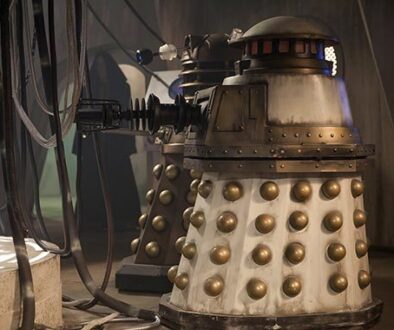The Witch’s Familiar Review
Clint Hassell gives his verdict on the second episode of Series 9.
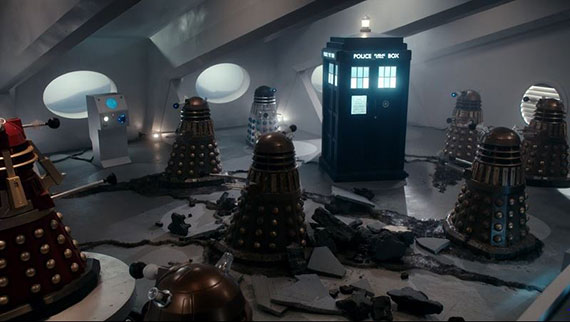
Supreme Dalek: “The TARDIS has been destroyed.”
The Doctor: “Oh, don’t be silly. Of course it hasn’t.”
Funny how a quote from this week’s episode fairly mirrors the response to last week’s cliffhanger, no?
To its credit, “The Witch’s Familiar” admits that the previous episode’s cliffhanger was silly, and dispenses with it quickly. Yes, the resolution was as uncreative as expected: despite the audience seeing the classic extermination effect (a narrative cheat) Missy and Clara were, of course, teleported to safety. However, writer Steven Moffat brilliantly mines the audience’s low expectations to craft a brilliant meta teaser where Missy imagines the Doctor being chased by 50 invisible android assassins. “Come on, you know the Doctor,” Moffat says, via Missy, “How did he escape?” That Clara comes to the same conclusion as the previous episode’s audience – – teleportation via extermination – – is no surprise, and serves as Moffat’s mea culpa.
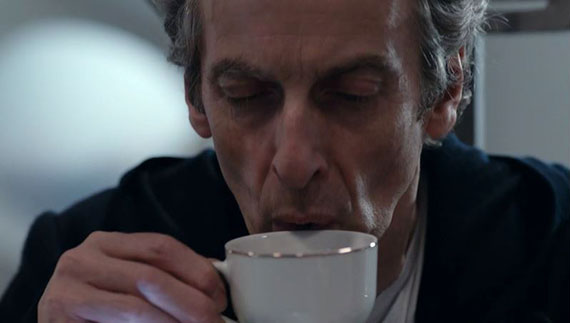
“The Witch’s Familiar” is full of genuine misdirects, too. The voiceover from Davros, seeking assistance, paired with footage of both a display tracking his chair’s movement towards the Dalek command center and external shots of flying Daleks hunting a Doctor that Davros says is escaping, belies the reveal that it is actually the Doctor in Davros’s chair. This is Moffat at his twisty best, playing with audience perception, rather than canon or plot logic. Here, he succeeds in fooling the viewer, and it stands in stark contrast to last episode’s cliffhanger.
Another example can be found in what must be the set-up of Series 9’s narrative arc. “The Magician’s Apprentice” conveniently painted Missy’s reception of the Doctor’s confession dial against the Time Lord’s visit to a dying Davros, leading the audience to believe that the Doctor is atoning for his abandonment of a young Davros. “The Witch’s Familiar” reveals that the two are unrelated. So, what did the Doctor do that requires confession, and portends his death?
Steven Moffat further subverts audience expectation by incorporating a great deal of humor into a script involving the Doctor’s greatest enemies. This is smart, as it gives the younger members of the audience several moments of hilarity – – “Can I have a stick, too?” “Make your own stick”; Missy pushing Clara into the Dalek sewer; “What about when it comes out?” “I’ve no idea. Nobody knows. Anyway . . .” – – to balance the very mature plotline of the Doctor and Davros connecting at the end of their respective lives.
The choice is not without risks. While the experiment largely works – – the reveal that, on all of Skaro, there are only two chairs is perfection – – it does portray the Daleks as ineffectual, yet again, undermining Moffat’s stated goal of portraying the Daleks formidable and scary. In the end, the Daleks fail to exterminate the Doctor or Clara. Who could have guessed that the plunger-wielding Daleks would be defeated by a backed up sewer?

Despite the emphasis on humor, “The Witch’s Familiar” actually capitalizes on a seemingly contrived plot point from “Asylum of the Daleks” to add another layer to the Dalek threat. It is not just that the Daleks are nigh-unstoppable, or without reason, “The Witch’s Familiar” reveals that the Daleks, more than any other monster in the mythology, understand the Doctor/companion relationship and are able to twist it to their advantage. At this point, the Daleks have created so much fear and destruction in the universe that they cannot trust the normally-pacifist Doctor to follow his personal moral code. Rather, they use the Doctor’s companions to coerce his behavior. Thus, the point of separating Clara from the Doctor, in “The Magician’s Apprentice.” As his moral center, Clara would have convinced the Doctor to not commit Dalek genocide, thus keeping the Doctor away from Davros’ trap. Conversely, what read as a convenient way to return Amy and Rory to Series 7’s narrative can now be seen as the Dalek’s ensuring the Doctor cooperation, via his companions.
Further, as in “Into the Dalek,” Moffat continues his examination of the Dalek psyche, revealing that, “I love you,” and, “You are different from me,” translate to “Exterminate!” Incidentally, this standard battle cry is how the Daleks rearm their weapons, which are tied to their fevered emotional states. This reveal certainly explains the frenzied mental condition of the Daleks, as they shot Clara, at the end of “The Magician’s Apprentice.”
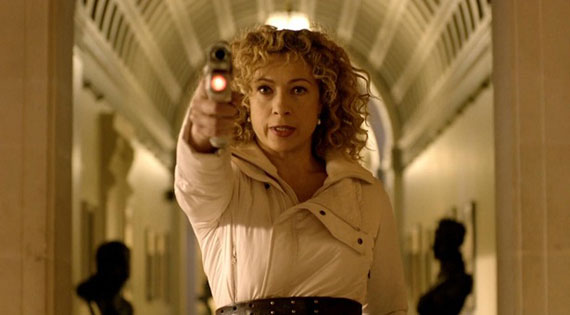
Compare this episode’s examination of the Daleks to that of Davros, seemingly heartbroken in his “most sincere congratulations” to the Doctor for saving Gallifrey:
“This is wonderful news, beyond all hope. . . . A man should have a race, a people, an allegiance. A man should belong. Doctor, believe me, please, I am so happy for you. So happy.”
Of course, a savvy audience realizes that Davros is far too great a character for a future showrunner to not resurrect. However, unlike last episode’s cliffhanger, Davros’ scenes are written with such honest poignancy that the audience could believe that Moffat, at least, meant for this to be the Davros’ swan song, further doubling the thrill when Davros’ ploy is revealed.
Beyond Davros and the Daleks, Moffat plumbs the psychological depth of the rest of the cast to achieve greater emotional realism than he did in “The Magician’s Apprentice.” For example, while Twelve is normally gruff and dour, he is not often as angry as he is when he tells Davros to “Get out!” of the stasis chamber. Further, Moffat pays off the teaser’s running stick joke with a short scene that updates the audience on the post-“Death in Heaven” dynamic between Clara and Missy. Clara is still willing to kill Missy and Missy is both insane enough to call her bluff and miserable enough to wish she’d do it. It’s a shame, as spare as “The Magician’s Apprentice” was, that this scene was pushed to “The Witch’s Familiar.”
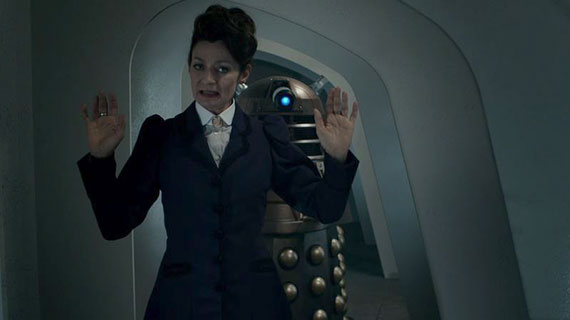
However, it is Missy that most benefits from the episode’s increased emotional realism and effective use of humor, which flesh out her character in ways unseen in episodes where she is featured as the leading antagonist. It is important to Doctor Who that, occasionally, someone saves the Doctor, and, after “Dark Water”/”Death in Heaven,” Missy is certainly due for redemption. However, it’s frightening how quickly the mercurial Time Lady shifts from rescuing the Doctor from Davros’ energy trap to urging him to kill a disguised Clara-cum-Dalek. The capricious duality of Missy’s whimsical and vicious natures emphasizes how self-serving and unhinged she truly is. Note her barely contained psychopathy when she describes her brooch as being able to penetrate the Dalek armor plating “like a knife through people.” Moffat not only compares the Doctor and Davros – – Davros’ “Am I a good man?” inquiry directly referencing the Doctor question to Clara, in “Into the Dalek” – – but also the Doctor and Missy, as Missy’s handcuffing Clara to a security monitor, to lure a Dalek into the open, recalls the Doctor’s grim actions in “Mummy on the Orient Express.”
To his credit, Moffat realizes that he can’t possibly have Missy “die” only to reappear later, three episodes in a row. He’s smart to leave her fate in the air, with her final line, “You know what? I’ve just had a very clever idea,” evidence of her capacity – – a move that actually bolsters the threat of her character.
Truly, the episode’s biggest misstep is the script’s expansion of the Dalek canon to include that Dalek physiology is “hardwired to keep on living no matter what happens,” yet also “rots” and “liquefies” from old age, the remains being poured into sewers. Not only does this fact defy the second law of thermodynamics, it is another example of a plot point that inorganically exists solely to justify a later plot point. Why is the vengeful, decaying Dalek goo not constantly attacking the healthy Dalek fleet? Because it can’t get inside Dalek tanks that haven’t been pierced by Missy’s brooch? Then how does the goo overcome the Dalek fleet, in the final act – – Daleks who have similarly been flushed with the same strengthening regenerative energies? Why doesn’t it attack Missy and Clara, who were not protected by armored shells?
Further, Davros explains that he is connected to the Dalek fleet, and feeds off their life force; however, in the episode’s resolution, the Doctor realizes that his regeneration energy has coursed through both the living and liquefied Daleks, indicating that Davros is connected to the dead Daleks, as well. Might this explain why Davros feels like he is dying? Or, at least, explain his eczema?
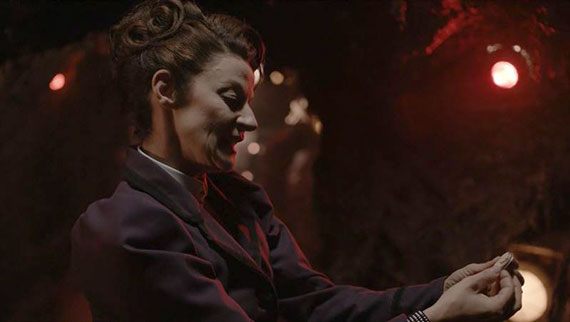
By almost completely ignoring the preceding episode, “The Witch’s Familiar” manages to become the entertaining, though-provoking series opener the audience deserves. Fittingly, in arguably the opening teaser’s most meta moment, Missy asks, “Why does the Doctor always survive?” “Because he always assumes he’s going to win,” Clara theorizes. While never directly stated before, this idea certainly explains the Doctor’s attitude in The End of Time, as Ten truly believed that his “song [was] ending.” Clara’s deciding that the best first action against “the deadliest race in all of history” is to “assume [they’re] going to win” resonates with a winsome hope, and demonstrates that the Doctor can inspire not just a young Davros, or an impossible girl, but an entire viewing audience as well. By using the narrative’s fantastical elements as a backdrop on which to examine the human condition, “The Witch’s Familiar” proves itself to be a great work of science fiction, and one of Steven Moffat’s best scripts, as showrunner.








